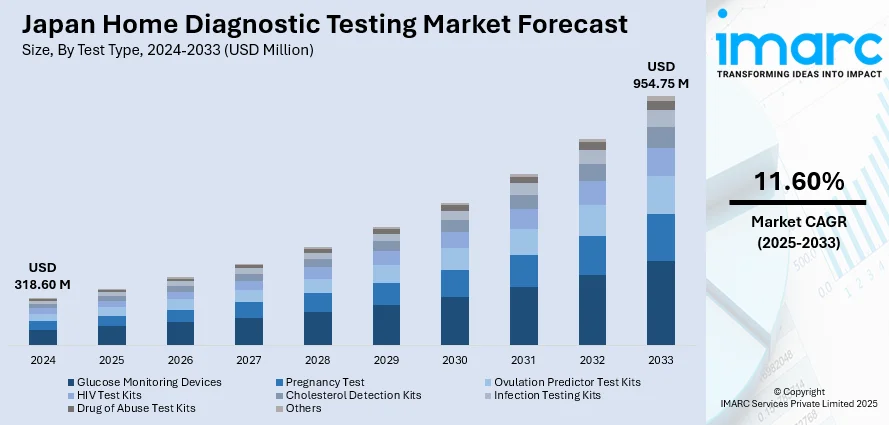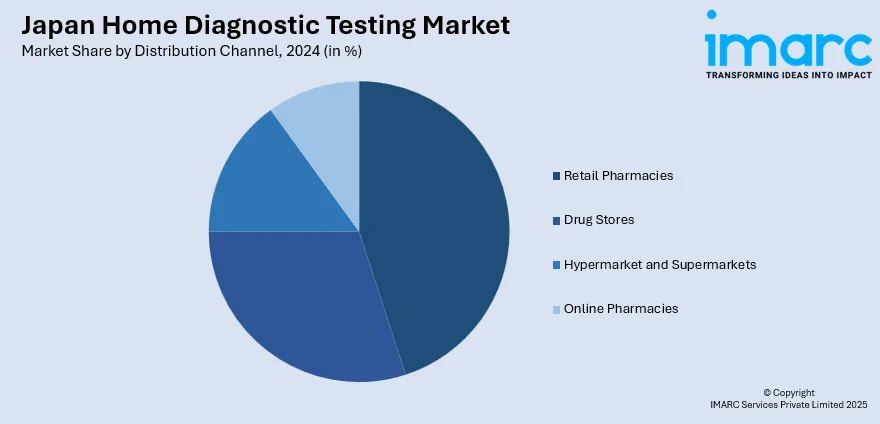
Japan Home Diagnostic Testing Market Size, Share, Trends and Forecast by Test Type, Form, Distribution Channel, and Region, 2025-2033
Japan Home Diagnostic Testing Market Overview:
The Japan Home Diagnostic Testing Marketsize reached USD 318.60 Million in 2024. Looking forward, IMARC Group expects the market to reach USD 954.75 Million by 2033, exhibiting a growth rate (CAGR) of 11.60% during 2025-2033. The market is driven by the country's aging population which has resulted in higher prevalence of chronic diseases like diabetes, cardiovascular diseases, and cancer, requiring frequent monitoring and early detection. Development in technology has also increased the reliability and precision of these tests, which has also improved consumer trust. Encouragement of the Japanese government toward healthcare innovation and digital health solution development has fostered a conducive environment for the growth of home diagnostic testing services which further supports the Japan home diagnostic testing market share.
|
Report Attribute
|
Key Statistics
|
|---|---|
|
Base Year
|
2024
|
|
{Forecast Years}
|
2025-2033
|
|
Historical Years
|
2019-2024
|
| Market Size in 2024 | USD 318.60 Million |
| Market Forecast in 2033 | USD 954.75 Million |
| Market Growth Rate 2025-2033 | 11.60% |
Japan Home Diagnostic Testing Market Trends:
Harmonization of Artificial Intelligence and Digital Health
The blending of digital health and artificial intelligence (AI) technologies is causing a significant change in the home diagnostic testing business in Japan. AI-enhanced diagnostic equipment, including intelligent glucose monitors and wearable electrocardiogram (ECG) devices, allow ongoing monitoring of health and early screening of potential health problems. These technologies allow intervention to take place in a timely manner and lower hospital visits without increasing dependence on caregivers. In addition, the embracement of digital health platforms enables easy exchange of data between patients and medical professionals, which results in more tailored and effective care. Japanese government efforts, including the "Medical Digital Transformation (DX) Promotion Plan," seek to sync up healthcare digitization with cloud-based electronic medical records (EMRs), AI-supported patient care, and improved data portability and security. This trend is part of a larger movement toward preventive medicine and the wish to effectively control chronic illnesses from the comfort of one's own home.

To get more information on this market, Request Sample
Growth of Direct-to-Consumer (DTC) Testing Services
The growth of direct-to-consumer (DTC) lab testing services is transforming Japan's in-home diagnostic testing market. Firms are providing an array of tests such as genetic testing, hormone level testing, and metabolic health testing so that consumers can obtain diagnostic care without a referral from a healthcare provider. Such a model gives control to individuals to manage their health and make informed choices through personalized information. Advancements in technology, including the application of AI and machine learning in diagnostic testing, are making DTC tests more accurate and efficient. Moreover, the proliferation of digital health platforms and telemedicine services is enhancing service access, especially in remote areas. The ongoing evolution of easy-to-use digital interfaces and mobile apps is further improving the overall consumer experience, further propelling the Japan home diagnostic testing market growth.
Government Assistance and Healthcare Policy Programs
The positive government policies of healthcare investment and active approaches toward healthcare policy are a key factor driving the home diagnostic testing market. Programs like the "Health Care 2035" vision focus on constructing a long-term healthcare system that yields outstanding health results based on responsive and equitable care. This vision is value-based care, empowering individuals, and global health security. The backing of digital health technology by the government, such as encouraging electronic medical records (EMRs) and artificial intelligence (AI) patient care, is building a good climate for the growth of home diagnostic testing services. Also, implementation of new regulations to improve data privacy and security for digital healthcare services is building consumer confidence and promoting the use of home diagnostic testing solutions. All these efforts are working together to drive the growth and expansion of the Japanese home diagnostic testing market.
Japan Home Diagnostic Testing Market Segmentation:
IMARC Group provides an analysis of the key trends in each segment of the market, along with forecasts at the country and regional levels for 2025-2033. Our report has categorized the market based on test type, form, and distribution channel.
Test Type Insights:
- Glucose Monitoring Devices
- Pregnancy Test
- Ovulation Predictor Test Kits
- HIV Test Kits
- Cholesterol Detection Kits
- Infection Testing Kits
- Drug of Abuse Test Kits
- Others
The report has provided a detailed breakup and analysis of the market based on the test type. This includes glucose monitoring devices, pregnancy test, ovulation predictor test kits, HIV test kits, cholesterol detection kits, infection testing kits, drug of abuse test kits, and others.
Form Insights:
- Cassettes
- Midstream
- Instruments
- Strips
- Test
- Digital Monitoring
- Dip Cards
A detailed breakup and analysis of the market based on the form has also been provided in the report. This includes cassettes, midstream, instruments, strips, test, digital monitoring, and dip cards.
Distribution Channel Insights:

- Retail Pharmacies
- Drug Stores
- Hypermarket and Supermarkets
- Online Pharmacies
The report has provided a detailed breakup and analysis of the market based on the distribution channel. This includes retail pharmacies, drug stores, hypermarket and supermarkets, and online pharmacies.
Regional Insights:
- Kanto Region
- Kansai/Kinki Region
- Central /Chubu Region
- Kyushu-Okinawa Region
- Tohoku Region
- Chugoku Region
- Hokkaido Region
- Shikoku Region
The report has also provided a comprehensive analysis of all the major regional markets, which include Kanto Region, Kansai/Kinki Region, Central /Chubu Region, Kyushu-Okinawa Region, Tohoku Region, Chugoku Region, Hokkaido Region, and Shikoku Region.
Competitive Landscape:
The market research report has also provided a comprehensive analysis of the competitive landscape. Competitive analysis such as market structure, key player positioning, top winning strategies, competitive dashboard, and company evaluation quadrant has been covered in the report. Also, detailed profiles of all major companies have been provided.
Japan Home Diagnostic Testing Market Report Coverage:
| Report Features | Details |
|---|---|
| Base Year of the Analysis | 2024 |
| Historical Period | 2019-2024 |
| Forecast Period | 2025-2033 |
| Units | Million USD |
| Scope of the Report |
Exploration of Historical Trends and Market Outlook, Industry Catalysts and Challenges, Segment-Wise Historical and Future Market Assessment:
|
| Test Types Covered | Glucose Monitoring Devices, Pregnancy Test, Ovulation Predictor Test Kits, HIV Test Kits, Cholesterol Detection Kits, Infection Testing Kits, Drug of Abuse Test Kits, Others |
| Forms Covered | Cassettes, Midstream, Instruments, Strips, Test, Digital Monitoring, Dip Cards |
| Distribution Channels Covered | Retail Pharmacies, Drug Stores, Hypermarket and Supermarkets, Online Pharmacies |
| Regions Covered | Kanto Region, Kansai/Kinki Region, Central /Chubu Region, Kyushu-Okinawa Region, Tohoku Region, Chugoku Region, Hokkaido Region, Shikoku Region |
| Customization Scope | 10% Free Customization |
| Post-Sale Analyst Support | 10-12 Weeks |
| Delivery Format | PDF and Excel through Email (We can also provide the editable version of the report in PPT/Word format on special request) |
Key Questions Answered in This Report:
- How has the Japan home diagnostic testing market performed so far and how will it perform in the coming years?
- What is the breakup of the Japan home diagnostic testing market on the basis of test type?
- What is the breakup of the Japan home diagnostic testing market on the basis of form?
- What is the breakup of the Japan home diagnostic testing market on the basis of distribution channel?
- What is the breakup of the Japan home diagnostic testing market on the basis of region?
- What are the various stages in the value chain of the Japan home diagnostic testing market?
- What are the key driving factors and challenges in the Japan home diagnostic testing market?
- What is the structure of the Japan home diagnostic testing market and who are the key players?
- What is the degree of competition in the Japan home diagnostic testing market?
Key Benefits for Stakeholders:
- IMARC’s industry report offers a comprehensive quantitative analysis of various market segments, historical and current market trends, market forecasts, and dynamics of the Japan home diagnostic testing market from 2019-2033.
- The research report provides the latest information on the market drivers, challenges, and opportunities in the Japan home diagnostic testing market.
- Porter's five forces analysis assist stakeholders in assessing the impact of new entrants, competitive rivalry, supplier power, buyer power, and the threat of substitution. It helps stakeholders to analyze the level of competition within the Japan home diagnostic testing industry and its attractiveness.
- Competitive landscape allows stakeholders to understand their competitive environment and provides an insight into the current positions of key players in the market.
Need more help?
- Speak to our experienced analysts for insights on the current market scenarios.
- Include additional segments and countries to customize the report as per your requirement.
- Gain an unparalleled competitive advantage in your domain by understanding how to utilize the report and positively impacting your operations and revenue.
- For further assistance, please connect with our analysts.
 Request Customization
Request Customization
 Speak to an Analyst
Speak to an Analyst
 Request Brochure
Request Brochure
 Inquire Before Buying
Inquire Before Buying




.webp)




.webp)












